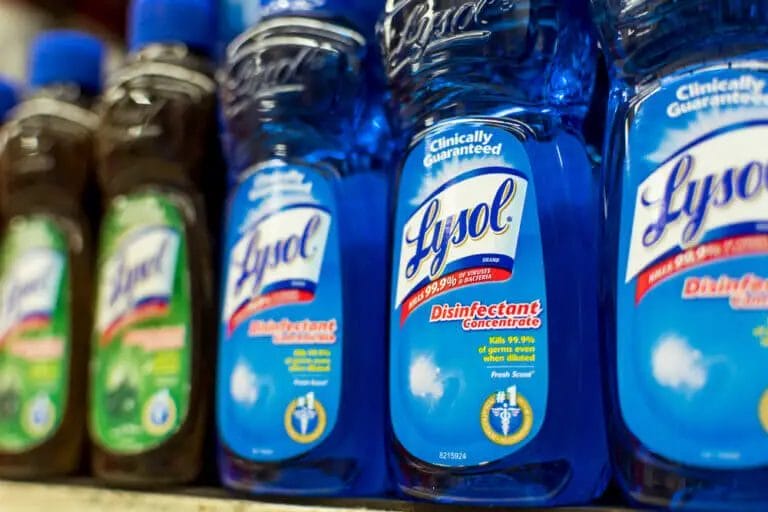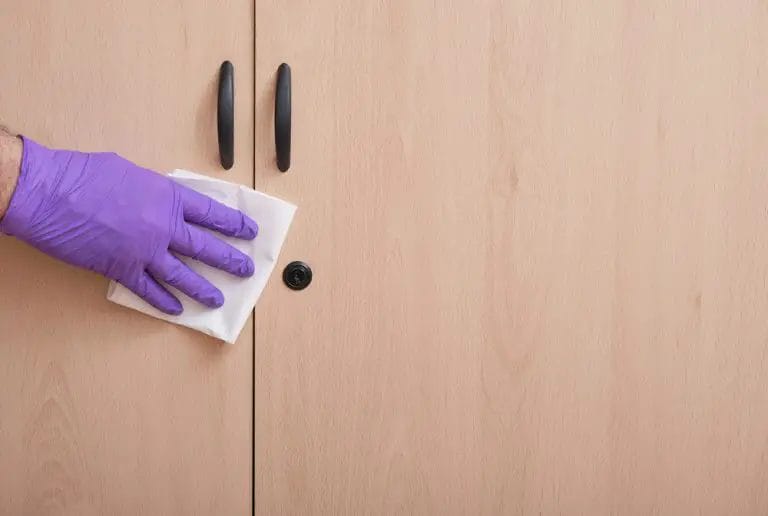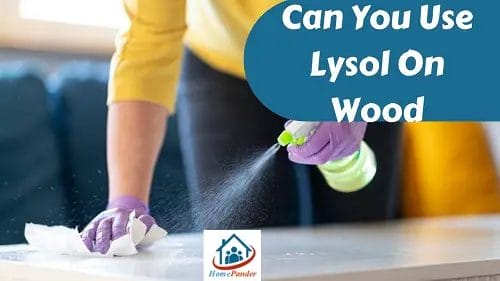If you’re wondering whether you can use Lysol on wood surfaces, the answer is yes. Lysol can be safely used on wood as a disinfectant, provided it is used properly. However, it is important to follow the specific instructions on the Lysol product label and test it on a small, inconspicuous area of the wood surface first to ensure it does not cause any damage or discoloration. Additionally, it is recommended to avoid prolonged exposure and excessive use of Lysol on wood.

Is it safe to disinfect wood with Lysol?
When it comes to cleaning and disinfecting surfaces, it’s important to choose the right product for the job. Wood surfaces, in particular, require special care as certain cleaning agents can damage or discolor them. One popular disinfectant on the market is Lysol, known for its effectiveness against germs and viruses. But, is it safe to use Lysol on wood? Let’s examine the facts.

Lysol is a widely recognized brand that offers a range of cleaning and disinfecting products. However, it’s important to note that not all Lysol products are suitable for use on wood surfaces. While Lysol disinfectant sprays and wipes are effective for killing germs on hard, non-porous surfaces, they may not be suitable for use on wood.
The main concern with using Lysol on wood is the potential for damage. Many wood surfaces, such as furniture, flooring, or cutting boards, have a protective finish that can be sensitive to certain chemicals. Lysol contains ingredients such as alcohol and other chemicals that can strip away the protective finish, leading to discoloration, warping, or other forms of damage.
That being said, there are certain Lysol products that are specifically formulated for use on wood surfaces. These products are designed to be gentle on wood while still providing effective disinfection. Look for Lysol products that are labeled as safe for use on wood or consult the manufacturer’s instructions for guidance.
If you’re unsure about using Lysol on your wood surfaces, it’s always best to err on the side of caution. Instead of using a disinfectant, opt for regular cleaning methods that are safe for wood. Dusting, wiping with a damp cloth, and using mild soap and water can effectively clean wood surfaces without the risk of damage.
Another option is to use natural disinfectants that are safe for wood. Vinegar and hydrogen peroxide are two common household ingredients that can effectively kill germs on wood surfaces without causing harm. These natural disinfectants are less likely to damage the protective finish of the wood.
In summary, while Lysol is a powerful disinfectant, it may not be safe to use on all types of wood surfaces. Always check the label or manufacturer’s instructions to determine if a specific Lysol product is suitable for use on wood. If in doubt, opt for gentle cleaning methods or natural disinfectants that won’t harm your wood surfaces.

Best Practices for Using Lysol on Wooden Items
When it comes to keeping our homes clean and germ-free, we often turn to disinfectant sprays like Lysol. However, when it comes to cleaning wooden items, it’s important to take extra care to ensure that the disinfectant doesn’t damage or ruin the wood’s finish. In this section, we will discuss some best practices for using Lysol on wooden items to effectively sanitize them without causing any harm.
1. Read and Follow the Instructions
Before using Lysol or any other disinfectant on your wooden items, it’s essential to read and follow the instructions provided by the manufacturer. The instructions will provide specific guidelines on how to use the product safely and effectively. Pay attention to any warnings or precautions mentioned, as these will help you prevent any potential damage to your wooden items.
2. Test in an Inconspicuous Area
Prior to applying Lysol to the entire wooden surface, it’s a good idea to test it in a small, inconspicuous area. Choose a hidden spot, such as the back or underside of the item, and apply a small amount of Lysol using a clean cloth or sponge. Allow it to sit for a few minutes, then wipe it off. Check for any signs of discoloration or damage to the wood’s finish. If there are no adverse effects, you can proceed with disinfecting the entire item.
3. Dilute the Lysol
Wood is a porous material, and direct application of undiluted Lysol can be too harsh and may cause damage. To prevent this, it is recommended to dilute the Lysol before using it on wooden items. Diluting the disinfectant will reduce its strength and minimize the risk of harm to the wood. Mix one part Lysol with one part water in a spray bottle or container, and gently shake to combine. This diluted solution can now be safely used on wooden surfaces.
4. Apply with a Soft Cloth
When applying Lysol to wooden items, it’s important to use a soft, lint-free cloth or sponge. Avoid using abrasive materials such as scouring pads or harsh brushes, as they can scratch or damage the wood. Dampen the cloth with the diluted Lysol solution and gently wipe the surface, ensuring thorough coverage. Be careful not to oversaturate the wood, as excessive moisture can cause warping or swelling.
5. Wipe off Excess Moisture
After disinfecting the wooden item, it’s crucial to wipe off any excess moisture to prevent it from penetrating into the wood. Use a dry, clean cloth to gently remove any remaining Lysol or water from the surface. This will help maintain the integrity of the wood and prevent any potential damage.
6. Allow Sufficient Drying Time
Give the wooden item ample time to dry completely before using or storing it. This will allow any residual moisture from the disinfectant to evaporate and prevent the growth of mold or mildew. Place the item in a well-ventilated area and ensure that it is thoroughly dry before returning it to its original location.
7. Apply a Protective Finish (Optional)
If you want to provide an extra layer of protection to your wooden items after cleaning them with Lysol, you may consider applying a protective finish. This can help seal the wood and guard against future damage. Choose a finish that is suitable for the type of wood you have, such as wax, varnish, or oil, and follow the manufacturer’s instructions for application.
Summary
When it comes to disinfecting wooden items using Lysol, it’s crucial to follow best practices to ensure both cleanliness and the preservation of the wood’s integrity. By reading and adhering to the instructions provided, conducting a test in an inconspicuous area, diluting the Lysol, applying it with a soft cloth, wiping off excess moisture, allowing sufficient drying time, and optionally applying a protective finish, you can effectively sanitize your wooden items without causing any harm. Remember to always prioritize the safety and longevity of your wooden items while maintaining cleanliness.

Alternative Disinfectants for Wood Surfaces
When it comes to cleaning and disinfecting wood surfaces, it is important to choose the right products that effectively kill germs and bacteria without causing any damage. While traditional disinfectants may work well on non-porous surfaces, they can be too harsh for wood. Fortunately, there are alternative disinfectants available that are safe and effective for cleaning wood surfaces. In this section, we will explore some of these alternative disinfectants and their benefits.
1. Vinegar
Vinegar has long been used as a natural cleaner and disinfectant due to its antimicrobial properties. It is especially effective against certain types of bacteria and viruses. When used on wood surfaces, vinegar can help remove stains, dirt, and odors, while also killing germs. To use vinegar as a disinfectant, simply mix equal parts vinegar and water in a spray bottle, and then spray it onto the wood surface. Allow it to sit for a few minutes before wiping it clean with a soft cloth.
2. Hydrogen Peroxide
Hydrogen peroxide is another alternative disinfectant that is safe to use on wood surfaces. It is a powerful oxidizer and can effectively kill bacteria, viruses, and fungi. To use hydrogen peroxide as a disinfectant, dilute it with water in a 1:1 ratio and apply it to the wood surface using a cloth or sponge. Allow it to sit for a few minutes and then wipe it clean. It is important to note that hydrogen peroxide can lighten the color of some types of wood, so it is recommended to test it on a small, inconspicuous area first.
3. Tea Tree Oil
Tea tree oil is a natural disinfectant that has antimicrobial properties. It is particularly effective against bacteria, fungi, and viruses. To use tea tree oil as a disinfectant for wood surfaces, mix a few drops of tea tree oil with water in a spray bottle. Shake well and then spray it onto the wood surface. Let it sit for a few minutes before wiping it clean. Tea tree oil also has a pleasant scent, which can help eliminate odors.
4. Alcohol-Based Disinfectants
Alcohol-based disinfectants, such as isopropyl alcohol or rubbing alcohol, can also be used to disinfect wood surfaces. These disinfectants are effective at killing germs and bacteria. To use an alcohol-based disinfectant on wood, simply apply a small amount to a cloth and rub it onto the surface. Make sure to fully cover the area and allow it to air dry. It is important to note that alcohol can dry out the wood, so it is recommended to moisturize the surface with a wood conditioner or polish afterwards.
5. Essential Oils
Some essential oils, like lavender oil, eucalyptus oil, or lemon oil, have natural antimicrobial properties and can be used as alternative disinfectants for wood surfaces. Mix a few drops of your chosen essential oil with water in a spray bottle and shake well. Then, spray it onto the wood surface and wipe it clean with a cloth. Essential oils not only disinfect the surface but also leave a pleasant scent behind.
In summary, when disinfecting wood surfaces, it is important to choose alternative products that are safe and effective. Vinegar, hydrogen peroxide, tea tree oil, alcohol-based disinfectants, and essential oils are all viable options. Remember to test any new disinfectant on a small, inconspicuous area first. By using the right disinfectants, you can keep your wood surfaces clean and germ-free without causing any damage.
Precautions to take when using Lysol on wood
Using Lysol to clean and disinfect surfaces is a common practice, but when it comes to using it on wood, there are some precautions that need to be taken. While Lysol can be effective in killing germs and bacteria, it can also cause damage to certain types of wood if not used correctly. Here are some important precautions to keep in mind when using Lysol on wood:
1. Test on a small, inconspicuous area:
Before applying Lysol to the entire surface of the wood, it is crucial to test it on a small, inconspicuous area first. This will help you determine if the wood reacts negatively to the disinfectant. Apply a small amount of Lysol on the test area and wait for a few minutes. If the wood shows any signs of discoloration, warping, or damage, do not proceed with using Lysol on the rest of the wood.
2. Dilute Lysol with water:
Lysol is typically used in its concentrated form, but when using it on wood, it is recommended to dilute it with water. Mix equal parts of Lysol and water in a spray bottle, and then apply the diluted solution on the wood surface. This will help lessen the potency of the disinfectant and minimize the risk of damage to the wood.
3. Use a soft cloth or sponge:
When cleaning wood with Lysol, it is important to use a soft cloth or sponge to avoid scratching or damaging the surface. Avoid using abrasive materials, such as steel wool or rough brushes, as they can leave marks or gouges on the wood.
4. Avoid excessive moisture:
Wood is susceptible to water damage, so it is essential to avoid excessive moisture when using Lysol. Spray a small amount of the diluted Lysol solution onto the cloth or sponge instead of directly onto the wood, to control the amount of liquid applied. Wipe the wood gently and ensure that it does not become overly wet. After cleaning, use a dry cloth to remove any excess moisture from the wood.
5. Follow manufacturer’s instructions:
Always read and follow the manufacturer’s instructions on the Lysol bottle. Different types of wood may have specific cleaning requirements, so it is important to use the product in accordance with the instructions provided. This will help you avoid any potential damage to the wood.
6. Apply a protective sealant:
After cleaning and disinfecting the wood with Lysol, consider applying a protective sealant to prevent any further damage. A sealant can help protect the wood from moisture and stains, prolonging its lifespan and maintaining its appearance.
7. Ventilate the area:
Lysol has a strong odor, so it is advisable to ventilate the area properly when using it on wood. Open windows or doors to allow fresh air to circulate, which will help minimize any lingering odors.
8. Store Lysol safely:
When not in use, store your Lysol in a cool, dry place, away from direct sunlight and out of reach of children and pets. Follow the storage instructions provided on the product label to ensure its effectiveness and longevity.
Summary:
When using Lysol on wood, it is important to take precautions to avoid any potential damage. Test the product on a small area, dilute it with water, use a soft cloth or sponge, avoid excessive moisture, follow manufacturer’s instructions, apply a protective sealant, ventilate the area, and store Lysol safely. By following these precautions, you can effectively clean and disinfect wood surfaces without causing harm.
FAQs
Can I use Lysol on wood?
No, it is not recommended to use Lysol on wood surfaces as it can cause damage. Lysol contains chemicals that may strip the finish, discolor the wood, or even cause warping. It is best to use wood-specific cleaners and follow the manufacturer’s instructions for cleaning and disinfecting wood surfaces.
How often should I clean and disinfect high-touch surfaces?
It is recommended to clean and disinfect high-touch surfaces at least once a day, or more frequently if they are frequently used or visibly dirty. This helps to prevent the spread of germs and maintain a hygienic environment. Follow the instructions on your disinfectant product for the recommended contact time and usage.
What is the difference between cleaning and disinfecting?
Cleaning and disinfecting are two different processes. Cleaning refers to the removal of dirt, dust, and impurities from surfaces, while disinfecting refers to killing or inactivating germs on the surface. It is important to clean a surface before disinfecting it, as disinfecting alone may not be effective if the surface is dirty. Use both cleaning and disinfecting products for optimal hygiene.
Conclusion
In conclusion, while Lysol is a popular disinfectant, it is not recommended to use it directly on wood surfaces. The harsh chemicals contained in Lysol can damage the finish and discolor the wood. Instead, opt for more wood-friendly cleaning methods such as using a mild soap and water solution or wood-specific cleaners. Additionally, it is important to regularly dust and vacuum wood surfaces to maintain their cleanliness and prevent the buildup of dirt and germs. By taking these precautions, you can effectively keep your wood surfaces clean and well-maintained without risking any damage from Lysol or other harsh disinfectants.